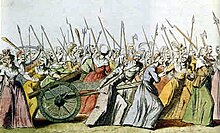Poissards
The Poissards or "fish women", actually a march of several thousand armed civilians and soldiers, fetched on 5./6. October 1789 Louis XVI. from the Versailles court to revolutionary Paris .
history
After the outbreak of the French Revolution in 1789, the National Assembly issued its August decrees in the same year , which aimed at the abolition of the privileges of the nobility in France ; however, Louis XVI, still nominal head of the state, refused to sign them and thereby give them legal force. Lack of supplies and military measures against mass rallies in Paris fueled the hostile mood towards the king. The news that the royal couple and their bodyguards had denigrated the revolution at a banquet led to open outrage. On October 5th, several hundred (market) women, who were subsequently referred to simply as Poissardes ("fish women ", also directly adopted as Poissards in German), gathered at the Paris City Hall and moved to the court in Versailles; The insurgent National Guard also made their way . The procession probably comprised several thousand people who voiced their social and political demands. The king submitted to this power and on the next day went to the Tuileries Palace in Paris, accompanied by the Poissards and the National Guard . The event caused a sensation across Europe, and the Poissards became a permanent fixture in the iconography of the revolution.
With the overthrow of the Jacobins in 1794, the bourgeois forces turned away from those revolutionary phenomena that they equated with radicalism and unrestrained action; this also included the Poissards . When the Helvetic Republic was established in Switzerland in 1798 based on the French model, the leading Basel revolutionary Peter Ochs warned against “leaving important changes in a state to day laborers, fishwives and second-hand traders”. Counter-revolutionaries rhymed for a long time: The revolution came "from completely rotten juices / And from burned brains / Fish women now chatter about state affairs / With outrageous foreheads" (Anonymous: parody of the parody of a German , o. O. 1792). At the end of the 1790s, the Poissards had become a horror for both friends and foes of the (controlled) revolution.
The market women moved to Versailles and invaded the National Assembly. They wanted to draw the king's attention to the poor supply of the city. After bloody clashes with the National Guard, Louis XVI. the constitutional article.
illustration
The poissards in the picture opposite are marked with their mixture of weapons (halberds, sabers, skewers) as improvised violence. The knives for eviscerating the fish should be noted, but above all the pikes as the real weapons of the revolutionary masses. At the head of the proletarian squad, however, is a wealthy citizen who is already wearing the classicist fashion of the later consulate and the empire . The picture cleverly plays with the groups involved in the revolution. The bourgeoisie is described as the leading new force, while it assigns the poissards the role of the senseless mob who can be won over to any riot.
The handwritten addition above the picture reads: “Heaven give that every citizen is free / And every citizen is without pants.” The words “ohne Hosen” are ambiguous: On the one hand, it is the misunderstood translation of the French sans culottes as a designation the revolutionaries who did not wear the noble culottes (shorts) with silk stockings, but the simple, long-legged pantaloons ; on the other hand, it is the mockery of the fact that in France the usual power relations between the sexes were called into question, as it was in this event, but soon also in the appearance of the revolutionary women's clubs or in the declaration of the rights of women and citizens of Olympe de Gouges showed.
See also
literature
- Chris E. Paschold, Albert Gier (ed.): The French Revolution - A reader with contemporary reports and documents. Reclam, Stuttgart 1989, pp. 101-116, ISBN 3-15-008535-7 .

